Current as of: April 3, 2025 - 16:19

Everest Treks in Comfort Trip Notes
- Ways to Travel: Guided Group
- Destination: Nepal
- Programmes: Walking & Trekking
-
Activity Level:
4 out of 7 - Moderate & Challenging
- Ages: 16+
- Trip Code: TNU
Trip Overview
The best mountain lodges, the finest Everest trails – take your next Himalaya hike to new heights
Elevate your hiking adventure in the Himalaya, taking the most scenic trails in the Everest region, while staying in the best lodges around. Guided by true mountain experts, we walk among giants etched into adventure folklore, soak up Sherpa culture and witness the world’s highest peaks from the best viewpoints. Each evening, you’ll sleep easy with a comfortable room and a little luxury, allowing you to be refreshed and ready for another adventure the following day.
Why trek with Exodus?
- One of the highest staff-to-traveller ratios on the trek with one staff member to every four travellers
- More than 30 years’ experience organising treks in Nepal
- Carefully planned ascent rates and itineraries with built-in acclimatisation and contingency days
- Established protocol for Lukla flight delays
- Exodus annually commissions independent air-safety audits on domestic carriers in Nepal and only use those approved as part of the audit
- Experienced English-speaking local leaders who are qualified in first aid and trained to recognise and deal with altitude sickness
- All staff (leaders, guides and porters) are fully insured and paid a fair wage
- Staff carry oxygen, a first-aid kit, and self-assessment acute mountain sickness cards, used to monitor every traveller at altitude
- Speak to Exodus office staff who have done the trek themselves
At a Glance
- Accommodation: 3 Premium nights (hotel), 7 Superior nights (mountain lodges)
- Seven days of walking with full porterage
- Group normally 4 to 16 plus tour leader and local staff. Minimum age: 16
- Altitude maximum: 12,706ft (3,873 m); average: 10,328ft (3,148m)
- Travel by private minibus and two internal flights
- Between five and seven hours of walking per day, with some longer days
Highlights
- Walk legendary trails in the Everest region, guided by true mountain experts
- Stay in the top mountain lodges around, allowing you to unwind after our hikes
- Soak up Sherpa culture in the bustling Namche Bazaar
- Head to the hilltop Tengboche Monastery for incredible mountain views
- Explore the monkeys and temples of Kathmandu
- Visit Sagarmatha Next to support the fight for trash-free Everest trails
Is This Trip for You?
This trek is graded Activity Level 4 (Moderate & Challenging). For more information on our trip gradings, visit the Activity Level Guidelines page. If you have any queries about the difficulty of the trip, please contact us.
Altitude: The maximum altitude is 12,706ft (3,873m) and the average is 10,328ft (3,148m). Ample time is given for acclimatisation, but altitude is a factor and must be considered – please refer to the altitude warning in the Trip Notes.
Fitness and ability: You should have some trekking experience (preferably at altitude) before joining this adventure. If you do not regularly exercise or hill walk, you should train beforehand.
- On most days, we walk for approximately five to six hours, although there are some shorter and longer days.
- This trek is graded Activity Level 4 (Moderate & Challenging) due to the altitudes and some long days walking. However, it is graded a lower Activity Level than our Everest Base Camp Trek as it does not go above 13,123ft (4,000m) and only spends eight days at altitude.
Heights: The trail crosses several modern suspension bridges, all of which have mesh sides; some are quite long and high, so anyone with a strong fear of heights or vertigo may find them difficult.
Walking hours: Those stated within the itinerary are approximates only. Timings stated exclude lunch stops and vary depending on the group’s pace. There are seven days of walking with full porterage throughout – you need only carry your backpack for the day.
Nepal flight safety
Many of our treks in Nepal use domestic flights to reach the trekking areas. The mountainous Nepalese terrain is subject to changeable weather, which makes flying conditions complex and challenging, and unfortunately there are significantly more incidents here than in other countries, including fatalities. The EU highlighted the poor safety record in Nepal by including all Nepalese-registered airlines on the EU banned list, which prevents them from flying in EU airspace. While no Nepalese-registered airlines currently fly within the EU, the EU instigated this ban to highlight the risk of flying in Nepal to EU citizens. Nepalese airlines are unlikely to be members of any internationally recognised safety audit systems and the Civil Aviation Authority (CAA) of Nepal does not operate to the same standards as those of Western nations.
Flying within Nepal is therefore a known risk, and we strongly encourage you to consider this carefully before booking. We suggest you refer to the following sources:
- The current travel advice for Nepal issued by the UK Foreign, Commonwealth and Development Office
- The Air Safety Network entry for Nepal
In response to concerns over this safety record, we arrange for independent air-safety auditors to visit Nepal annually to assess the suitability of the available carriers. We then restrict our use to only those approved as part of this audit. In emergency situations, we will need to use helicopters, so we also have a list of approved helicopter carriers. Should concerns arise regarding the safety of an airline on our approved list, we will remove the carrier from the list immediately; it would only be reinstated once our air-safety auditors are confident the airline meets acceptable safety standards.
We appreciate you may have concerns about flying within Nepal, so we ask that you please consider all the information above when deciding to book this trip.
Internal flight delays
Adverse weather conditions at Lukla airport occasionally mean that flights to/from Manthali or Kathmandu cannot operate. Please read the Important Information section of the Trip Notes for more information.
Group
The group is generally between four and 16 people.
We have representatives in Kathmandu who look after your transfers to and from the airport and are around to answer other questions you may have about your trek.
All departures have an English-speaking Nepali tour leader throughout, who is assisted by Nepali trekking guides. All our tour leaders are highly experienced, trained in wilderness first-aid, and have taken our tour leader training courses. The trekking guides are licensed by the Trekking Agencies’ Association of Nepal (TAAN) and receive additional training through us. The trekking guides walk with the group, spacing themselves out to ensure the pace is appropriate for careful acclimatisation and to ensure the safety of everyone in the group, helping those who may need some encouragement or support.
On all our Nepal treks, there is one trek staff to every four travellers – this ratio may change if a guide has to stay behind with a group member. The tour leaders are assisted by additional guides and as many porters or dzos (cow-yak hybrids) as necessary to carry the kitbags. All your main gear is carried for you, and you only have to carry whatever you require for that day’s trek. Dzos carry four kitbags each and porters carry two – kitbags should be 22lb (10kg) maximum. All trekking staff are insured by our local partner in Nepal.
Adult min age: 16
Min group size: 4
Max group size: 16
Itinerary
Land Only
- Start City: Kathmandu
- End City: Kathmandu
Land Only Itinerary
Begin your adventure in Kathmandu, the start point for countless Himalayan adventures and the capital of Nepal.
You’re met at the airport and transferred to the hotel. At 6pm, bid namaste to your tour leader and fellow travellers, when we gather as a group for the first time to get to know each other and learn more about the adventures ahead.
Your tour leader then ensures a big Nepalese welcome by arranging dinner at a great local restaurant.
Want to explore Kathmandu further? Secure pre-tour hotel nights through your sales representative.
Accommodation: Hotel Yak & Yeti (or similar)
Leave very early (approximately 3am!) for the four-hour drive to Manthali Airport, where we catch one of the first morning flights to Lukla. The hotel provides us with packed breakfasts, which we eat en route.
Our flight takes us to the newly resurfaced mountain airstrip, and we enjoy a refreshing welcome tea at a Lukla lodge before commencing our first trek.
Pass through several villages before stopping for lunch at a beautiful riverside spot, below the base of the Kusum Kanguru mountain. Passing a majestic mani stone at Thada Kosi river, we reach our Phakding lodge.
After, enjoy free time at the riverside lodge or opt for a short trip to a higher village and a delightful tiny gompa perched on the valley side. In the evening, we gather for drinks by the fire, followed by a delightful meal at a newly built restaurant overlooking the Dudh Kosi river.
Accommodation: Mountain Lodge of Nepal, Phakding (8,701ft/2,652m)
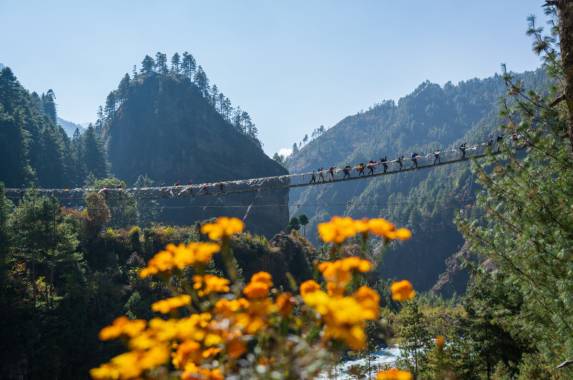
Heading out of Phakding, we follow the Dudh Kosi north. Today’s walk is one of the toughest of the trip, but we take it slowly, enjoying the scenery as we climb slowly up to Namche Bazaar. The trail is well marked and comfortably broad, while walking in the cooler part of the morning means it is easier to breathe and gradually get used to the increasing altitude.
Along the way, there are two suspension bridges to cross as we zig-zag along and across the Dudh Kosi, passing through the Sherpa villages of Benkar, Monzo and Jorsale. A final bridge brings us to the foot of the steep climb to Namche. Halfway up the ascent, we may get our first glimpse (cloud permitting) of the Everest summit behind the great ridge of Nuptse-Lhotse.
A last 985ft (300m) climb brings us to Namche Bazaar, the Sherpa capital and the main town in the area. It always bustles with trekkers, coffee shops, bakeries and stores selling all kinds of trekking and climbing gear and Tibetan souvenirs.
We suggest visiting Sagarmatha Next, a non-profit dedicated to keeping the local hiking trails waste-free. Support their project (and pick up something for home) by purchasing one of their impressive souvenirs made from litter collected from the Himalaya.
Accommodation: Mountain Lodge of Nepal, Namche (11,285ft/3,440m)

In the morning, there’s time to visit the Sagarmatha National Park Museum and Tenzing Norgay Memorial before heading to Tashinga.
Our route follows the classic approach to Everest. We keep to the almost-level winding trail for about 2hr 30min before taking a slight detour off the main trail; after a short walk, we arrive at our lodge for the night.
There is time to relax in the afternoon and enjoy views of Ama Dablam, Kusum Kanguru and Thamserku.
Accommodation: Everest Summit Lodge, Tashinga (11,319ft/3,450m)
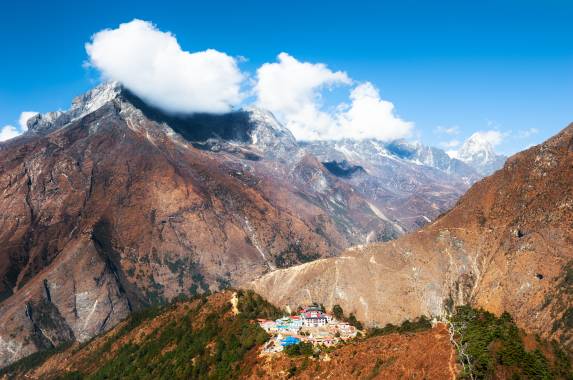
Looking across the valley from the lodge, we can see the path sloping diagonally upwards to Tengboche Monastery.
Begin the trek by descending to the small hamlet of Phunki Tenga, which lies beside the Dudh Kosi. Cross the suspension bridge before beginning a steep ascent for about an hour. This part of the trail passes through fairly heavy forest of rhododendron and pine, so it is well shaded and cool. Once out of the forest, the trail becomes gentler and more gradual all the way to the monastery.
The setting of Tengboche is magical, backdropped by some of the most brilliant peaks in the Himalaya. The monastery itself was accidentally burned down in 1989 but was rebuilt thanks to the expertise of local Sherpa communities and support from international organisations.
After a leisurely lunch and tour of the monastery and its surroundings, we retrace our steps to Tashinga.
Accommodation: Everest Summit Lodge, Tashinga (11,319ft/3,450m)
Leaving Tashinga, we retrace part of our route to Namche Bazaar for about an hour. Then we detour off the main trail, taking the path to Khumjung village, which heads gently up the shallow valley and into Khumjung, the education centre of Khumbu.
Time permitting, we visit the Khumjung Monastery and Kunde hospital. From here, we continue to take the high trail above Namche Bazaar, bypassing Syangboche airport. The valley ahead is extremely rugged but beautiful; as we wander along the forest track, look out for monal pheasants and small herds of thar.
At the small village of Tesho, we turn off the main trail and head slowly up a closed valley. The last half hour of the climb to Mende is short, steep and guaranteed to take your breath away. This is where the past few days of hiking will be appreciated!
At the lodge, the awesome views make the effort of getting there well worth it.
Accommodation: Everest Summit Lodge, Mende (12,257ft/3,736m)
Before beginning the descent to Monjo, we visit Laudo Monastery, 15 minutes’ walk above Mende. The main temple is only 40 years old and was used until recently as a meditation school for Western students of Buddhism. It has a remarkable meditation room built underneath a huge rock, where people go on retreat for three years, three months or three days. The friendliest caretaker in the whole of Khumbu will be more than happy to serve butter tea and explain a little about the monastery.
Following our visit, we begin the decent, retracing our path to Phurte; from there, we take the lower trail to Namche. After three hours of easy walking, we arrive at Namche Bazaar for lunch. The rest of the trail is an easy descent to Monjo.
Accommodation: Everest Summit Lodge, Monjo (9,314ft/2,839m)
The return trek to Lukla follows a slightly different route to avoid walking through Phakding again. Keeping to a trail high above, on the other side of the Dudh Kosi, we visit the old Gumila Monastery before descending to the main trail.
After a short lunch break at Thada Kosi, we continue for a further two hours or so before we reach Lukla.
Accommodation: Everest Summit Lodge, Lukla (9,317ft/2,840m)
Fly back to Manthali Airport on one of the first flights of the day (approximately 7am to 7.30am) to allow for the five to six-hour bus transfer back to Kathmandu, arriving in the city mid to late-afternoon.
That gives you time to enjoy the excellent hotel facilities, perhaps with a post-trek spa treatment or dip in the garden pool. There are also two excellent restaurants to enjoy or speak to your tour leader for their local recommendations.
Accommodation: Hotel Yak & Yeti (or similar)
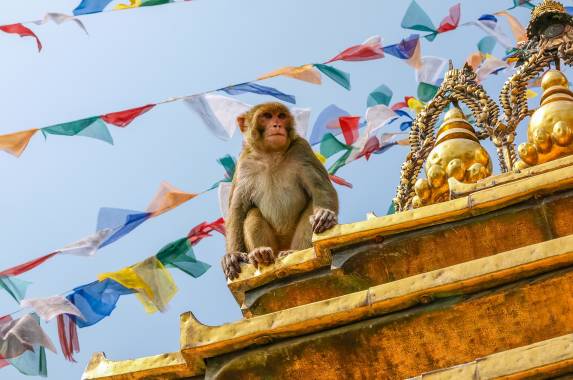
This morning, we meet our local city guide and visit Swayambhunath, the Monkey Temple, a great introduction to the rich history and spiritual significance of Kathmandu. It’s perched on a hill, offering panoramic views of the city and Kathmandu Valley. The site is known not only for its religious importance but also for the playful rhesus macaque monkeys that roam around, adding to the charm and unique atmosphere of the place. It’s a peaceful spot to take in both the natural beauty and religious devotion of Nepal.
Then, moving to Kathmandu Durbar Square, we dive into the history and architecture of the city. Despite damage from the 2015 earthquake, this World Heritage site still showcases incredible buildings, temples and statues from the Malla kings era. The restoration efforts are ongoing, so it’s fascinating to see the blend of old and new. The square is also home to the Kumari Ghar, the residence of the Kumari, the Living Goddess, who is believed to be the earthly manifestation of the goddess Taleju. Visitors often catch glimpses of her from the balcony.
From Durbar Square, we walk to the buzzy Thamel district via the old market for your last chance to pick up souvenirs.
Accommodation: Hotel Yak & Yeti (or similar)
The tour ends after breakfast, so it’s time to start your return journey home. If you’d like a little more time to explore Kathmandu, speak to your sales representative about extending your stay.
Post-trip Extensions
Chitwan Safari Extension
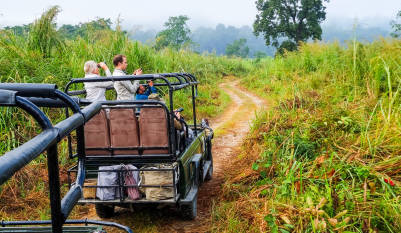
A five-day wildlife extension is the ideal opportunity to explore the lowlands of Nepal and enjoy rest and relax after the challenges of your trekking journey.
Travel from Kathmandu to your jungle lodge in search of roaming wildlife at Chitwan National Park. With the help of an expert naturalist, you explore the home of the one-horned rhino, while also spotting birds, crocodiles, deer and boar. Find a more detailed itinerary here.
Please ask your sales representative for more details. Prices listed are starting prices.
Price per person
£ 749
Mandatory Single Supplement
£ 365
Altitude Warning: This trip includes one or more nights over 9,845ft (3,000m) above sea level, where there is a genuine risk of being affected by acute altitude illnesses; if left untreated, this can be life-threatening. Most should expect to experience some mild symptoms of altitude sickness, such as headaches, shortness of breath or sleeplessness. Our leaders are trained to identify symptoms of severe altitude illnesses and, if a customer requires extra care, arrangements such as a rapid descent will be made.
Exodus itineraries are informed by the Wilderness Medical Society (WMS) Guidelines for the Prevention of Altitude Illnesses and designed to allow for adequate acclimatisation. Due to terrain and/or logistical factors, there may be nights where the sleeping altitude gain is more than 1,640ft (500m), increasing the risk. The WMS highlight that because the rates of acclimatisation and physiologic responses to high altitude vary considerably between individuals, the recommendations given, although generally effective, do not guarantee successful prevention. Participants should be aware of the inherent risk posed by altitude.
Several medical conditions or medications can affect a person’s ability to acclimatise, making them more susceptible to acute altitude illnesses. Those with pre-existing conditions, such as heart or lung conditions, those who have suffered with altitude sickness before, or those with concerns about overall physical ability, should consult their doctor before booking. The drug Diamox (acetazolamide) may aid acclimatisation in some individuals. Those considering using Diamox should speak to their doctor about the drug, its suitability, side-effects, and a prescription. Please note, while we endeavour to assist all our customers in achieving their goals, there may be times when a leader decides to delay or stop someone’s ascent based on their condition.
If you are not taking out Exodus Travel Insurance, make sure your policy covers you up to the maximum altitude on this trip (if trekking in the Himalaya your policy should also cover the use of a helicopter for emergency medical evacuation).
Ascents, descents and distances: All ascents, descents and distances listed in the daily itinerary have been measured by our local partners or tour leaders, in many cases with satellite-based mapping software. However, different GPS measuring devices can give differing results, particularly on winding paths or in mountainous terrain. Measurements stated throughout these Trips Notes are given to help you understand the types of terrain and distances you will encounter. Timings stated will vary depending on the pace of your group.
Accommodation
Hotel Yak & Yeti and superior mountain lodges

Unwind in our expertly curated, handpicked accommodations on this mountain adventure. Each has been chosen for its excellent location, comfort, style, and unique characteristics.
Kathmandu: Hotel Yak & Yeti (nights 1 and 9-10)
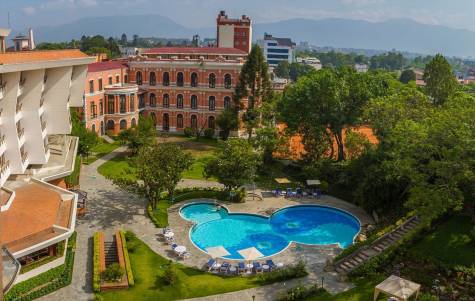
A five-star heritage hotel in the buzzy Thamel district, the Yak & Yeti is the ideal spot to start and end this adventure. It’s close to plenty of city landmarks, including Durbar Square, while the garden pool, spa and wellness centre allow you to relax when you’re not out exploring. Come dinner time, The Chimney offers Asian-Western fusion dishes, while The Spice Room serves a fine-dining take on Indian cuisine.
Himalaya mountain lodges
Staying in teahouses is a time-honoured tradition for most hiking trips within the Himalaya. Most are basic, but for this trip, we’ve taken comfort seriously and use Superior properties throughout.
Staying in a mixture of Everest Summit Lodges and Mountain Lodges of Nepal properties during the trek, you’ll arrive to warm welcomes, meals on half-board basis and comfortable bedrooms, including all bed linen, warm duvets and bathrooms with hot water!
The lodges we choose are in prime mountain-view locations and become a welcome sight after a day of hiking. We stay in twin-share bedrooms, which come with foam mattresses, bedsheets and a pillow. Below are a few of the lodges we use.
Phakding: Mountain Lodge of Nepal (night 2)
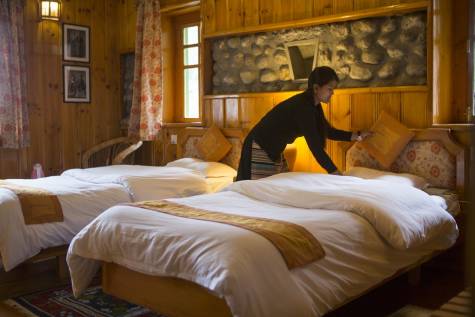
Our Phakding lodge has an idyllic spot in the Dudh Kosi gorge, just before a small bazaar. The rooms are finished in a combination of traditional Khumbu and modern styles – for a blissful sleep, ask the hotel staff to turn on your electric blanket before you go to bed! Also make sure to stroll over to the vegetable garden to see what seasonal produce you might be served at dinner.
Namche: Mountain Lodge of Nepal (night 3)
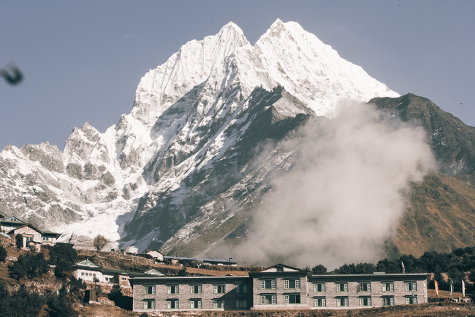
Our Namche lodge sits on the upper slopes of Namche, the Sherpa capital, close to the Sagarmatha National Park headquarters and a five-minute walk from the Sherpa Culture Museum. It also has a revitalising spa, providing a peaceful retreat amid the stunning Himalayan views.
Tashinga: Everest Summit Lodge (nights 4-5)
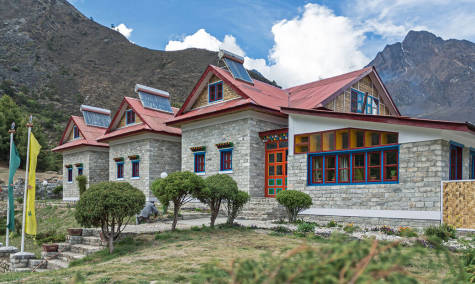
In an almost uninhabited village, this lodge is situated among pine forest, from where you can gaze over Ama Dablam, Kangtega, Thamserku and other Himalayan giants. The lodge is newly renovated and offers the highest standard of service and hospitality in the area. The rooms have private bathrooms with hot showers and fresh, warm bed linen for a tranquil night’s sleep.
Mende: Everest Summit Lodge (night 6)

Mende is off the beaten path, on a ridge overlooking the Everest Base Camp trail. Perched almost 12,795ft (3.900m) high above the Thame Valley, it offers spectacular views of Kongde Ri, Thamserku, Kang Taiga, Kusum Kanguru and Khumbila. Expect excellent hospitality with clean, warm bedrooms and hot running water, a welcoming dining room and even wifi!
Worth knowing
- Extra accommodation: If you require additional accommodation in Kathmandu, either before or after the tour, we can book this for you (subject to availability). Please enquire with your sales representative.
- Single accommodation: If you prefer your own room, we offer a single supplement for the hotel nights in Kathmandu and the mountain lodges (subject to availability).
Food & Drink
Breakfast is included throughout the trip, as are eight dinners (a welcome dinner in Kathmandu and half-board on trek).
Lunches are taken at lodges en route – sometimes one of your guides will go ahead with the group’s order to make it more expedient.
Breakfast and dinners in the lodges range from traditional Nepalese food to Chinese and Western dishes. The food is good quality and usually buffet style. You are provided with safe drinking water on trek.
Meat is available in the lodges, but we advise against eating it. Meat is often carried in the heat for several days before reaching the lodges and can cause stomach upsets or illness. Germs can also be spread by handling dirty money – we recommend using hand sanitiser.
Dietary requirements
- Gluten-free diets: We strongly recommend you bring extra food and snacks with you to supplement the food on trek as there will be little variety available to you, particularly for breakfast. Even many of the soups are powdered and contain gluten. Gluten-free breakfast options are limited to vegetable fried rice and a choice of egg. On specific days only, a trekkers breakfast (without the toast/with an extra egg) will be served.
- Vegan diets: Breakfasts are limited to a choice of muesli/porridge made with water each day, and on specific days only, a trekkers breakfast (without the egg) or vegetable fried rice.
- Lactose-free diet: The same will apply although you will also have a choice of egg each day.
Drinking water
Staying hydrated is vital at altitude, where it is generally recommended to drink at least 0.7gal to 1gal (three to four litres) per day.
We strongly encourage you not to buy bottled water on trek as this contributes to the growing plastic pollution problem in Nepal.
All lodges provide free cold water. This should not be drunk untreated, so we recommend you bring a reusable bottle/water bladder/CamelBak (ideally two and wide mouth) and use an effective form of water treatment. There are a wide range of products available including Steripens or purification tablets, which are the quickest and easiest options to use on trek – we recommend talking to an outdoor retailer for the latest advice as technologies are improving all the time. Make sure to check the product’s performance in cold/freezing conditions and consider battery life (lithium batteries are best in cold conditions).
Exodus has partnered with Water-to-Go, a filtration system that eliminates more than 99.99 percent of all microbiological contaminants from any non-saltwater source – visit Water-to-Go for more information. Exodus customers can claim 15 percent off their first order and, better still, 15 percent of the purchase value will be donated to the Exodus Travels Foundation. These bottles filter the water as you drink, though the spout may not be the most efficient while moving on trek. Please note, if the water freezes it will clog up the filter. In this event, defrost before use by sitting the filter in lukewarm water for 10-15 minutes.
Transport
For airport transfers, we use a private minibus. Flights to/from Lukla are usually in a Twin Otter or Dornier plane.
All flights to and from Lukla operate in/out of Manthali Airport (RHP). The journey from Kathmandu to Manthali is a four-hour bus drive in the early morning and the return leg from Manthali to Kathmandu is usually five to six hours due to heavier traffic later in the day. The flight time between Manthali and Lukla is about 20 minutes.
It is necessary to depart your hotel in Kathmandu at approximately 3am by bus to ensure arriving in Manthali for 7am-7.30am in time for the flights to Lukla (between 8.30am-9am). Your Kathmandu hotel will provide a packed breakfast for the journey.
Please read our note on flight safety in Nepal in the Is This Trip for You? section of our Trip Notes.
This trekking trip requires you to walk between each overnight stay under your own steam. Other forms of transport may be available along the route (horses, 4x4s etc) but we cannot take responsibility for the safety or cost of any transport that you choose to take, even if provided with the assistance of our leader or staff.
Weather & Seasonality
The main trekking season in Nepal is from October to mid-May when daytime temperatures at most altitudes are generally comfortable for walking, the sky is clear much of the time and rain and snow are occasional occurrences. Daytime temperatures will vary from 15C to 35C (59F to 95F) in the Kathmandu Valley to around 10C (50F) at 11,810ft (3,600m) and progressively lower the higher we go. Different seasons offer different advantages for trekking.
Post-monsoon/autumn: Mid-September to November
The main trekking season in Nepal. Day temperatures in Kathmandu are approximately above 20C (68F). Skies are usually clear and days on trek are sunny and mild with clear mountain views. Nights will be colder with temperatures dropping as low as -10C (14F) at the highest altitudes.
Winter: December to end of February
Despite the cooler conditions, this is an ideal time to trek in Nepal. Skies are usually very clear, especially in December, and the mountain views are at their best. Nights are very cold with temperatures down to -20C (-4F) at the highest altitudes but days are pleasant and sunny. The trails are also much less busy at this time of year. In Kathmandu, maximum daytime temperatures are 19C (66F).
Pre-monsoon/spring: March to May
Both day and night temperatures are warmer in general but often a haze builds in the afternoons. It is very hot in the lowlands and temperatures rise to 35C (95F) in Kathmandu. Flowers bloom in this season, one of the reasons people chose to trek in spring.
Snow should be expected on any departure, usually at the higher altitudes.
Please remember, the weather is never wholly predictable in any mountain area, and you should be equipped to deal with any differences in weather beyond the conditions described above.
Joining Instructions
Key information
Start hotel: Hotel Yak & Yeti, Durbar Marg, Kathmandu 44600, Nepal
Phone: +977 1424 8999
Recommended arrival time: You can arrive at any time today. There will be a welcome briefing and group dinner in the evening, but if you miss it the leader will update you separately.
Airport: Kathmandu Airport (KTM)
Getting to the start hotel
The start hotel is approximately 30 minutes’ drive from the airport. We provide free arrival transfers to the start hotel from the airport for all.
If you would like further information on joining this trip, please speak to your sales representative.
Catching your return flight
We provide free departure transfers for everyone to Kathmandu Airport (KTM) from the end hotel.
Please note, unless specified otherwise, the transfers will be to the start (or pre-tour) hotel and from the end (or post-tour) hotel and will be on the date on which the tour starts/ends; transfers to other hotels in the same city and/or on different dates may attract an extra charge. Transfers should be booked with your sales representative at least two weeks before the tour starts.
Full joining instructions including local emergency numbers will be sent to you as part of our Final Joining Instructions. If you do not receive these at least a week before departure, or require them earlier please contact our office or your travel agent.
Location start: Kathmandu
Location end: Kathmandu
What To Take
Essential Equipment
It is essential you have suitable clothing and equipment for your trek to protect against the elements and trail conditions. Please download our Everest region kit list for reference.
You do not need a sleeping bag, sleeping mat or towel for this trip. As these are all provided at your mountain lodges.
All luggage for the trek should be packed in a soft kitbag/Exodus kitbag. Many people find it easiest to pack the kitbag inside a wheelie case, which can be left at the Kathmandu hotel free of charge with anything not needed for the trek, while the kitbag is carried by your porter on the trek.
When packing, please consider the quantities/volume of the items you bring. Consider decanting larger toiletries into small reusable bottles to limit weight and volume (do not bring full-size bottles), take a lightweight travel towel etc. Animals are usually used for porterage and each carries four kitbags (where human porters are used, they carry two bags each), therefore please limit your kitbag to 22lb (10kg) maximum per person. There is also a weight restriction on the flight to/from Lukla of 22lb (10kg) checked baggage plus 11lb (5kg) hand luggage. If your check-in luggage exceeds this, there is an excess luggage charge (approximately US$1.20 per kilogram).
Your leader weighs each bag before departing Kathmandu and may ask those with overweight bags to remove non-essential items to leave in Kathmandu.
There can be unseasonal snowfall on any trek. You may want to bring a pair of Yaktrax (mini-crampons) or similar if you have a pair. If your leader thinks there may be snowfall, they will recommend carrying a pair for safety. It is possible to buy them in Kathmandu or Namche cheaply.
Please note, many Nepalis wear traditional clothing, so we suggest you dress conservatively. T-shirts are preferable to sleeveless tops and it is not advisable to wear tight or revealing clothing. Although long shorts (knee length) are acceptable, we recommend a skirt for women rather than shorts for the trek.
- One passport photo for your trekking permit
- Three to four-season jacket (four-season for November/December departures)
- Refillable water bottle/water bladder (also known as a hydration pack/CamelBak, which are useful for rehydrating on the go)
- Water purification treatment/Steripen
- Waterproof walking boots (worn in)
- Waterproof jacket and trousers (pants)
- Trainers (sneakers)/sandals for the evening
- Warm hat
- Scarf/buff (which can be pulled over your nose and mouth to protect against fine mountain dust)
- Gloves
- Several pairs of walking socks
- Thermals
- Warm mid-layer (fleece)
- Light/mid-weight trousers (pants) (warmer for winter)
- Walking shorts or a skirt for women
- Shirts/T-shirts or base layers
- Sunhat, sunglasses, sunscreen, and lip salve with sun protection
- Backpack for carrying belongings during the day (25-30 litre)
- Small personal first-aid kit
- Hand-washing gel
- Biodegradable mini toiletries for the trek (please do not bring full-size items and limit to essentials)
- Headtorch (head lamp)
- Plastic bags (bin liners) to line backpack and for packing clothing in the kitbag
- Plug adaptor
- Solar charger/spare batteries/powerbank
Equipment hire
You can hire a good-quality down jacket through us (from £63/US$69). It weighs approximately 3.9lb (1.8kg), please take this into account when packing due to the porterage weight limit. Hire equipment should be requested in advance of travel to ensure availability but will be provided locally in Kathmandu.
Exodus kitbag: If you book this trip, we provide a free Exodus kitbag to pack your luggage in while on trek. Once you have booked, you will be sent instructions on how to claim your bag (they are not sent automatically). Please note, if you book less than three weeks before the departure date, we cannot guarantee your kitbag will arrive before your trip starts. If this is the case, please contact us on customerops@exodus.co.uk (or customeroperations@exodustravels.com if you’re based in the US or Canada). See www.exodus.co.uk/kitbags for full T&Cs.
Optional Equipment
- Mosquito repellent (March to May)
- Trekking pole(s) – highly recommended due to the numbers of steps encountered on this trek
- Yaktrax or mini crampons
There are many equipment shops in Kathmandu where you can buy much of the above clothing. The quality does vary and cannot be guaranteed. You should choose carefully.
Donations for porters, children and the elderly
If you find a spare bit of space in your bag while packing, you may be interested in donating to one of Exodus’ projects. Exodus supports a Porter Clothing Bank in Kathmandu, as well as children in local schools in Kathmandu and various villages, and a care home in Kyanjin Gompa in the upper part of the Langtang Valley. If you have any old walking gear, this can be donated to porters, and, similarly, any warm clothing or blankets would be appreciated by the care home – please leave these items with your leader or at the Exodus desk at the Royal Singi Hotel. Books, stationery, games, warm clothes/underwear etc suitable for children aged five to 18 should be taken to the Ambassador Garden Home in Thamel and given to Prakash Lammichanne. Contact number: +977 1 4700724.
Practical Information
Passport
Your passport must be valid for at least six months when you submit your application for a visa. You should also ensure your passport is up to date, is valid for the entire length of your stay and that you have completed the emergency contact details page inside your passport.
Visa
Nepal
You can obtain your visa in advance or on arrival. The Immigration Department of Nepal has suspended visas on arrival for certain nationalities – please check if this applies to you with your nearest embassy or consulate.
Visa in advance
Apply for this through your local consulate or embassy. Further details on this option can be found here:
- For UK passport holders: https://uk.nepalembassy.gov.np/visa/
- For US passport holders: https://us.nepalembassy.gov.np/tourist-visa/
When applying for your visa in advance, the Nepalese government has an online application system (see links above for more info), but it is currently only accepting payments through Nepalese payment channels. Once the online form is completed, the applicant is required to print out the form and either send it, together with the passport, to the embassy, or attend in person.
Visa on arrival
- When you arrive at Tribhuvan International Airport in Kathmandu, there will be three lines. If you have already secured your visa, go straight to the Immigration line. If not:
Fill in a tourist visa form at the electronic kiosks. After inserting your passport, the machine will automatically fill out an application form, take an electronic photograph of you and print a paper slip. If the machine won’t read your passport, complete the details manually using the touchscreen. We recommend taking a passport photo with you just in case.
Top tip: This process can be completed through the online immigration portal (click ‘Visa On-Arrival’) within 14-days prior to arrival in Kathmandu, helping you to avoid lengthy queues at the kiosks when you come through immigration – ensure you print and bring the confirmation with you. If you have completed your visa on arrival form in advance, go directly to the visa fees counters with your printed confirmation and skip the kiosk queues. - Proceed to the visa fees collection counter and pay the visa fee (in cash, if possible). Make sure to keep the receipt. Card payments are not always possible, so paying in cash is easiest, most currencies are accepted but US dollars are preferred.
- Go to the relevant immigration desk and present your tourist visa form, payment receipt and passport to obtain your 15-, 30- or 90-day visa stamp. Please check you have been given the correct visa duration.
Vaccinations and Health
Nepal
There are no required vaccinations. However, recommended vaccinations include tetanus, typhoid, hepatitis A, hepatitis B, cholera, Japanese encephalitis, rabies and tuberculosis. You will also need a yellow fever vaccination certificate if you’re arriving from a country with risk of yellow fever transmission or transiting for more than 12 hours through a country with risk of yellow fever transmission. Some travellers may also need proof of a polio vaccination. Please confirm with your doctor or travel clinic.
There is little to no risk of malaria in Nepal; therefore, antimalarial tablets are not usually advised although may be considered for certain high-risk groups. You may wish to consult your doctor or travel clinic for further advice.
Additionally, dengue fever and chikungunya are known risks in Nepal. Both are tropical viral diseases spread by daytime biting mosquitoes. There is currently no vaccine or prophylaxis available for either, and therefore the best form of prevention is to avoid being bitten. We recommend you take the usual precautions to avoid mosquito bites.
Most of our trips to Nepal go to high altitudes where there is a risk of being affected by Acute Mountain Sickness. Our itineraries are designed to enable everyone to acclimatise to these altitudes, but you should be aware that it is still possible for you to be affected. Please refer to the Altitude Warning within the Trip Notes for further advice on AMS.
When trekking at altitude, and particularly in cold weather, there is a higher chance of developing a cough (sometimes referred to here as the Khumbu cough) or cold symptoms. These symptoms could be a result of inhaling cold mountain air or dust (in the Everest region). You can mitigate against picking up coughs and colds by washing your hands with soap and water at available opportunities and using hand sanitiser. Also wear a buff over your neck and mouth when walking at altitude, particularly in colder weather, which will help limit cold, dry air entering your airways and keep your neck and chest warm.
Ticks are known to be present in this region and can carry lyme disease, tick-borne encephalitis and other diseases. Please take care to protect yourself. You can read more about ticks here.
Local Time
Nepal's time zone: Asia/Kathmandu (UTC +05:45)
Electricity
Nepal’s electricity: Plug types C (two round pins, European standard), D (three round pins) and M (three round pins) – 230V, 50Hz
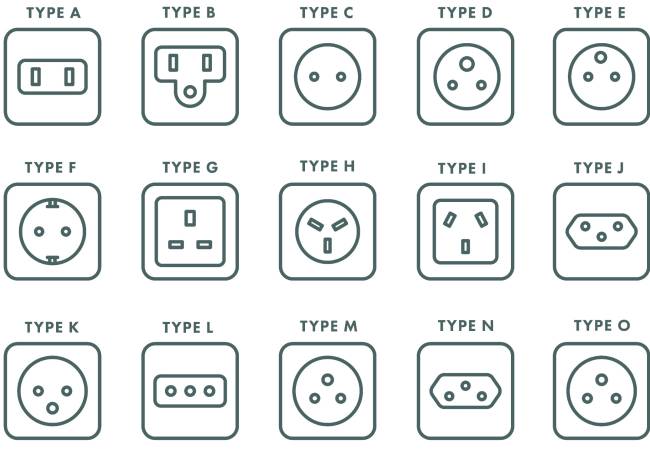
Money
Nepal's currency: Nepalese rupee (NPR) It is illegal to import or export rupees, but foreign currency is not limited, provided it is declared on arrival. Keep your change receipts, as you will need them if you want to change rupees back into hard currency at Kathmandu airport.
ATM Availability
There are ATMs in Kathmandu and other major towns. On trek, there is an ATM in Namche Bazaar, but it often doesn’t work so please do not rely on it. You need to carry cash for the trek.
Please do not rely wholly on ATMs as many are broken or run out of money. Often there are ATM lounges (a small room with numerous ATMs). Some banks have a withdrawal limit equivalent to US$122 per time. If you need to withdraw more, you should look for another ATM with a higher limit (others have a maximum withdrawal limit equivalent to about US$368 per time) as there is usually a transaction fee.
Credit cards are accepted in many of the larger shops and restaurants in Kathmandu and in most lodges in Namche Bazaar but are no use elsewhere on trek.
Extra Expenses & Spending Money
We recommend taking your personal spending money in cash (US dollars, British pounds or euros can all be changed easily). Any marked, torn or damaged notes may not be accepted. Please remember, £50 notes, Scottish or Northern Irish currency cannot be changed in Nepal.
Cash can be changed easily at the airport on arrival in Kathmandu or at money changers in the Thamel area of Kathmandu. Hotels in Nepal can also change up to US$300 per person. Our staff will advise you about how much money to take with you on trek.
You need to withdraw/exchange enough money in Kathmandu to last the duration of your trek – to cover meals, drinks, tipping and other incidentals. It is a good idea to carry spare cash on the trek in case of an emergency. Carrying a large amount of cash is unavoidable, so we suggest splitting it up into a few different places – but remember to keep track of how much you have stashed where.
Prices of food and amenities in teahouses generally become more expensive the higher altitude/more remote you are and access to ATMs/money changes are extremely limited. Please allow 4,200 rupees (US$30) per day for lunch, snacks and drinks on trek, and for meals not included in Kathmandu. This amount is given as a rough guideline only.
Optional excursions
An optional Everest sightseeing flight is available on your free day (weather permitting) from around 28,100 rupees (US$215) per person (the price is subject to change). Anyone taking an internal sightseeing flight in Nepal should pay attention to the statement ‘Flying in Nepal’.
Tipping
Tipping is customary in Nepal. Your tour leader usually offers to arrange and look after a group tipping kitty, which will be used to tip hotel porters, local guides, assistant guides, porters, and the drivers. Your tour leader will suggest how much to contribute, depending on group size, but a rough guideline is provided below.
Tipping of the tour leader is at your discretion and separate to the amount for the other staff. We suggest you send an envelope around the group at the end of the trip, and you can put in what you like and give it to the leader on the last evening.
The following are guideline amounts received by each staff member from the group as a whole
- Tour leader: 25,000-28,000 rupees (usually given on the last night in Kathmandu)
Your trekking crew (tips are usually given on the last evening of the trek in Lukla)
- Trekking guides: 12,000-15,000 rupees for each guide
- Trek porters/yak men: 9,000 rupees for each porter or yak man
General tipping guidelines:
- Kathmandu/Manthali Airport transfers: 1,000-1,500 rupees for each driver
- Drivers (shorter journeys): 200-300 rupees
- Hotel porters: 100 rupees each time for each room
- Teahouses and lunch stops on trek: It’s customary to round your bill up to the nearest 50 or 100 rupees
- Restaurants: 10% of the bill for good service
To help budget for the tips, generally there will be one member of trek staff (guide/assistant) for every four travellers. You will also have one porter for every two travellers to carry your luggage. If you are unsure how much to personally budget, you can check with your tour leader when you arrive in Kathmandu. It is preferable to give all tips in local currency where possible.
Sustainability and Impact
As a certified B Corp, we’re on a mission to improve our social and environmental impact across all our adventures.
We do this through our innovative Thriving Nature, Thriving People plan.
This ‘nature positive’ approach is designed to help nature and communities thrive in harmony though practical solutions, such as reducing carbon and waste on our trips, supporting conservation projects through the Exodus Adventure Travels Foundation, and rewilding 100 square metres for every Exodus traveller.
Important Information
Optional activities and excursions
If you would like to join an optional activity or excursion outside those listed in the itinerary, your leader may be able to assist with selecting a provider. However, Exodus has not assessed the safety standards of activities or excursions that are not listed in the Trip Notes. All optional activities or excursions are undertaken at your own risk.
Important Information
Your safe participation
When booking this trip, you should be confident in your ability to participate in all activities described in these Trip Notes. If you have any doubt about your suitability, please call us and ask to speak to one of the experts on this itinerary.
Although our leaders are well trained to deal with different capabilities, if they have any concerns about someone’s ability to safely take part in an activity, or their impact on other people’s enjoyment, we authorise them to take necessary action which, in some circumstances, may involve asking someone to miss that activity.
By booking this trip you agree to our Booking Conditions which clearly state that our leaders have the authority to do this. In these rare instances we will ensure anyone sitting out is safely provided for and offered alternative options where possible. Refunds will not be provided for activities missed and customers may be liable for additional costs incurred.
Seatbelts
All vehicles used by us should be equipped with working seatbelts, except where approved by us based on the vehicle type or journey. Wherever seatbelts are available, we require our customers to use them for their own safety, even where it may not be a legal requirement.
How to Book
- Check availability: Go online to check availability, or contact us by phone or email.
- Secure your place: You can provisionally hold a place on this trip, usually for between three and seven days.
- Complete your booking and payment
When you’re ready to book, go to our website for online bookings, book over the phone or you can complete a booking form (available online or on request by calling us). We accept all major credit and debit cards, or you can pay be cheque.
After booking
You will receive your booking confirmation letter and invoice, which includes extra information and guidance about your travel arrangements.
Full joining instructions, including local emergency numbers and details of how to reach the start point, will be sent to you approximately two to three weeks prior to departure. If you do not receive these at least a week before departure, or require them earlier, please contact our office or your travel agent.
Trip Note validity
These Trip Notes are valid from the “Current as” date on page one. They will occasionally be updated after booking and before departure; if there are any updates that significantly impact the inclusions or itinerary, customers will be written to separately. They will also receive a link to the most up-to-date Trip Notes with their Final Joining Instructions before travelling.
The information in these Trip Notes is given in good faith. Where differences exist between the Trip Notes and our current brochure or website, the Trip Notes supersede the brochure and website. All holidays can be subject to unexpected changes; to enjoy them you should be prepared to be flexible where necessary. Occasionally, it may not be possible to follow the itinerary as planned. This may be for a variety of reasons – climatic, political, physical or other. In these circumstances we will make the best-possible alternative arrangements that maintain the integrity of the original itinerary.
Licensing
Exodus is fully licensed and bonded as a tour operator. We hold Air Traffic Organisers Licence (ATOL) number 2582, issued and bonded with the Civil Aviation Authority (CAA). We are also bonded to the International Air Transport Association (IATA) and we are members of the Federation of Tour Operators (FTO) and ABTA – The Travel Association. This means you can book your Exodus holiday with confidence, as all money paid to us for your trip is fully protected.